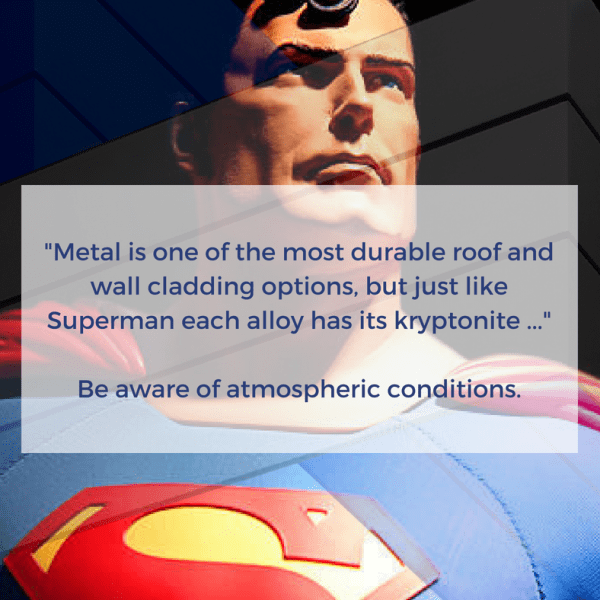In Part One of this blog series we looked at ways to start your cladding journey, focusing on inspiration and discovery. With a firm idea of what appeals, the next step towards specification is to explore the real world feasibility of metal cladding on your project.
While metal facades can be durable and long lasting, just like many other building products, there are limitations. To avoid over complicating this specification phase, we’re going to focus on the following key areas:
- System suitability
- Material to system comparability
- Atmospheric restrictions
- Project budget constraints
System suitability
While most systems are flexible, not all profiles have the same application suitability. If you’re looking for roof or roof and wall cladding, Standing Seam, Nailstrip, Snaplock, Batten Seam, Shingle or Flatlock are potentially appropriate selections. Interlocking and Cassette profiles are best kept to wall cladding specifications.
In high wind load areas, Double Lock Standing Seam is always advised, and in some cases alternative facade products will be suggested.
Material to system compatibility
Most cladding profiles offer complete material flexibility, but there are some exceptions. We generally recommend the following:
- Nailstrip: COLORBOND® Steel, COLORBOND® Steel Matt, Vestis aluminium
- Snaplock: COLORBOND® Steel, COLORBOND® Steel Matt, Vestis aluminium, natural copper
- Standing Seam: COLORBOND® Steel, COLORBOND® Steel Matt, Vestis aluminium, natural copper, titanium zinc, Weathering Steel/Corten
- Interlocking: COLORBOND® Steel, COLORBOND® Steel Matt, Vestis aluminium, natural copper, titanium zinc, Weathering Steel/Corten
- Flatlock and Shingle: COLORBOND® Steel, COLORBOND® Steel Matt, Vestis aluminium, natural copper, titanium zinc, Weathering Steel/Corten
- Cassette: Weathering Steel/Corten, special order aluminium (heavy gauge)
Atmospheric restrictions
Metal is one of the most durable facade cladding options, but just like Superman each alloy has its kryptonite. Salt laden air, chlorine, and harsh industrial environments can affect long term material performance. Any alloy can be installed in any location, however it’s important to keep in mind the location of a project may result in a reduced warranty period, or in some cases, no warranty at all. For coastal, aquatic, or industrial developments, contact our specification team for clarification on where you stand in regard to warranty, cleaning expectations, and predicted long term material performance.
The list below is a general performance guide for some of our most popular materials in marine environments:
- COLORBOND® Steel (standard): 12 years on projects located 1km or greater from the coast. No warranty on projects less than 1km
- COLORBOND® Steel Matt – 12 years on projects located 1km or greater from the coast. No warranty on projects less than 1km
- COLORBOND® Steel Ultra – 12 years on projects located 500m or greater from the coast. No warranty on projects less than 500m (available in six standard colours, other colours available on request)
- Aluminium – up to 40 year warranty on projects greater than 3km from the ocean, up to 20 years on projects located 1km-3km and up to a 10 year warranty on projects located less than 1km
- Titanium Zinc – non-coastal, expected lifespan 70+ years, no warranty offered for marine applications, however some treated zinc products will perform well
- Natural Copper – no warranty offered, but the material is expected to perform well in non-coastal and coastal applications. Salt laden air accelerates the material’s oxidisation process, meaning it won’t corrode, but it will age at a faster rate
- Weathering Steel – not recommended for use in coastal environments
Project Budget Constraints
It’s all well and good to design the most incredible facade, using only the finest metals – but if your budget can’t handle it, what’s the point? Metal cladding is a premium product. Architectural sheet metal profiles are an investment and a long term facade solution. Some systems are more affordable to install than others and different materials vary greatly in price.
When considering metal cladding, contact our project team during the design phase to understand cladding costs. We can put forward indicative supply and install prices, suggest economic panel widths, cost effective systems, and compare material costs.
What are you waiting for? Contact our team and let’s get started!
If you’re considering metal cladding panels on your next project, our team are here to assist and answer any questions you have. From metal samples to technical project assistance and specification guidance, we’re happy to discuss all aspects of sheet metal cladding panels, from manufacturing and fabrication through to installation and maintenance. To get in touch and learn more, click the button below.
Contact us


